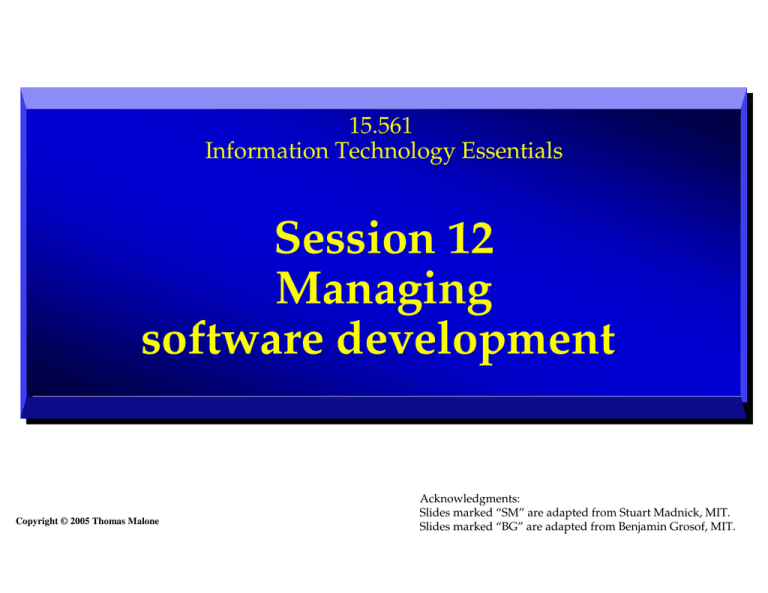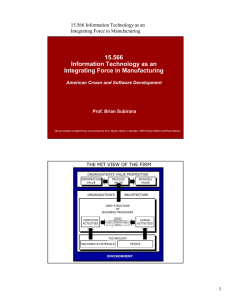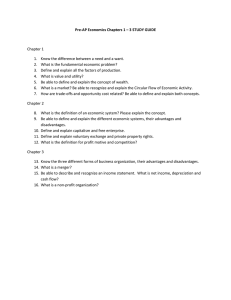Session 12 Managing software development 15.561
advertisement

15.561 Information Technology Essentials Session 12 Managing software development Copyright © 2005 Thomas Malone Acknowledgments: Slides marked “SM” are adapted from Stuart Madnick, MIT. Slides marked “BG” are adapted from Benjamin Grosof, MIT. Approaches to software development • Traditional systems development life cycle • Prototyping • Packaged software • End-user development • Outsourcing • Open source Traditional systems development life cycle (“waterfall” model) Project definition High level requirements Systems analysis Detailed requirements Design Decomposition into modules Programming Writing and testing code Deployment Installation and operation (sale) Maintenance Fixing bugs and changing features BG Traditional systems development life cycle • Advantages – For well-understood problems, produces predictable outcomes • Disadvantages – Inflexible – Long delay before any useful results » May be obsolete by then – Often hard to know requirements until actual use Prototyping Project definition Identify basic requirements Develop a working protoype Use the prototype User satisfied? No Revise and enhance prototype Yes Deployment Maintenance BG Prototyping •Advantages – Especially useful when exact requirements are hard to know in advance » user interfaces » decision systems » electronic commerce? – Encourages user involvement •Disadvantages – Hard to predict and control outcomes reliably – If repeated, significant reimplementations are needed, can be very expensive – May result in systems that are inefficient, unreliable, or hard to maintain Packaged software Project definition Identify basic requirements Select package Customize package Redesign organizational processes Train users Operation Operation Packaged software •Advantages – By amortizing development and maintenance costs over many organizations, it is possible to get superior solutions at much lower cost •Disadvantages – Customizing software can be very time-consuming and expensive – May have to change organization to fit software, rather than vice versa End-user development User recognizes need User acquires development tools User implements solution User uses the solution User satisfied? No User revises and enhances solution Yes Done End-user development • Advantages – Can be much faster – Improved requirements determination – Increased user involvement and satisfaction • Disadvantages – – – – – Often, users lack the right implementation skills Many problems can’t be solved within the limitations of the tools Lack of quality assurance and standards for programs and data Lack of sharing of programs and data Reduced opportunity for reuse of results BG Outsourcing • Contract out the performance of any or all of the above steps to another firm • Advantages – – – – Economies of scale Flexibility Predictability Freeing up human resources and capital • Disadvantages – Loss of control – Vulnerability of strategic information – Dependency Open source Someone develops working prototype Use the prototype Some developer wants to do more? No Yes Revise and enhance prototype Project ends Open source •Advantages – Usually lower cost – Sometimes easier to adapt “packaged” software to own needs – “Philosophically” appealing to many people •Disadvantages – Usually lower quality support – Only a few kinds of software are currently available in this format (Linux operating system, Apache web server, etc.) Problems with software development • Computerworld magazine* – “Nearly one-third of all projects fail” – “More than half come in over budget” – “Only 16% of all projects come in on time and on budget” • Key factor for success or failure: – “User involvement/input” *Survey of 8000 projects from 385 companies. SM Facts and Fallacies about Software Development •Facts – The most important factor in software development is the quality of the programmers. – The best programmers are up to 28 times better than the worst. – Adding people to a late project makes it later. – One of the most common causes of runaway projects is poor estimation. – The other most common cause of runaway projects is unstable requirements. – Requirements errors are the most expensive to fix during production. – Maintenance typically consumes 40 to 80 percent of software costs. – Enhancements represent roughly 60 percent of maintenance costs. Adapted from Robert L. Glass, Facts and Fallacies of Software Engineering, Addison Wesley, 2003. Facts and Fallacies about Software Development (cont.) •Fallacies – Software needs more methodologies. – You teach people how to program by showing them how to write programs. Adapted from Robert L. Glass, Facts and Fallacies of Software Engineering, Addison Wesley, 2003. Why is software hard?




